
Bulletin
wall bulletinMenu
- Overview
- Country analysis
- Argentina
- Australia
- Bangladesh
- Brazil
- Canada
- Germany
- Egypt
- Ethiopia
- France
- United Kingdom
- Indonesia
- India
- Iran
- Kazakhstan
- Cambodia
- Mexico
- Myanmar
- Nigeria
- Pakistan
- Philippines
- Poland
- Romania
- Russia
- Thailand
- Turkey
- Ukraine
- United States
- Uzbekistan
- Vietnam
- South Africa
- Afghanistan
- Belarus
- Mongolia
- Sri Lanka
- Zambia
- Mozambique
- Kenya
- Angola
- Hungary
- Italy
- Morocco
- UK
Authors: 超级管理员 | Edit: Miao
Winter wheat, which was sowed in October, is the major crop in the field during this monitoring period.
Agro-climatic conditions were generally stable as compared to average, except for a minor rainfall deficit but very sunny weather (RAIN 260 mm or -8.4%, TEMP 0.8℃ or +0.1℃ above average, RADPAR 181.8 MJ/m2 equivalent to a +12.6% anomaly). All the arable land was cropped (CALF at 100%) and the maximum vegetation condition index (VCIx) was high (0.98). As a result of good crop growth conditions, weather based projected biomass would increase by 7.2%. At the national level, the NDVI based crop condition development graph was gradually recovering to normal in January after a period in December when it was below both the 5-year average and the 2017-18 winter season values. According to the spatial distribution maps, VCIx was satisfactory in most areas of the country (>0.8). NDVI fluctuated very widely over the country; in the West (43.8% of cropped area), the value fell from 0.2 in late November to -0.4 at the end of January, a rather unusual behavior which will need close monitoring during the next reporting period
Regional analysis
Based on cropping system, climatic zones and topographic conditions, regional analyses for four agro-ecological zones (AEZ) are provided, including Northern Belarus, Central Belarus and Southern Belarus.
Northern Belarus (Vitebsk, northern area of Grodno, Minsk and Mogilev) was short in rainfall (-12%) with normal temperature (+0.0℃) and abundant radiation (+16%). Biomass production should be 7% higher 5YA. Agronomic indicator show very satisfactory values: 100% for CALF and 0.95 for VCIx. Crop condition is good.
In Central Belarus, the Regions of Grodno, Minsk and Mogilev on average recorded rainfall 3% lower than reference values, but normal temperature (+0.1℃) and higher radiation (+11%). The BIOMSS is projected to increase 7%. Combined with fully cropped arable land (CALF at 100%) a VCIx value of 0.94 shows good prospects for winter crops. NDVI curve also showed a recovering trend since January. In summary overall situation was favorable for winter crops.
The Southern Belarus (southern halves of Brest and Gomel regions) experienced the same agro-climatic condition as Northern and Central area. Slightly low rainfall (-12%) has not adversely affected the crops. Other favorable agro-climatic conditions (TEMP +0.1℃, RADPAR +10%) and favorable agronomic indicators (CALF 99%, VCIx 0.91, BIOMSS up 6%) as well as rapidly recovering NDVI should ensured satisfactory crop production.
Figure 3.xx. Belarus crop condition, October 2018- January 2019

(a) Phenology of major crops
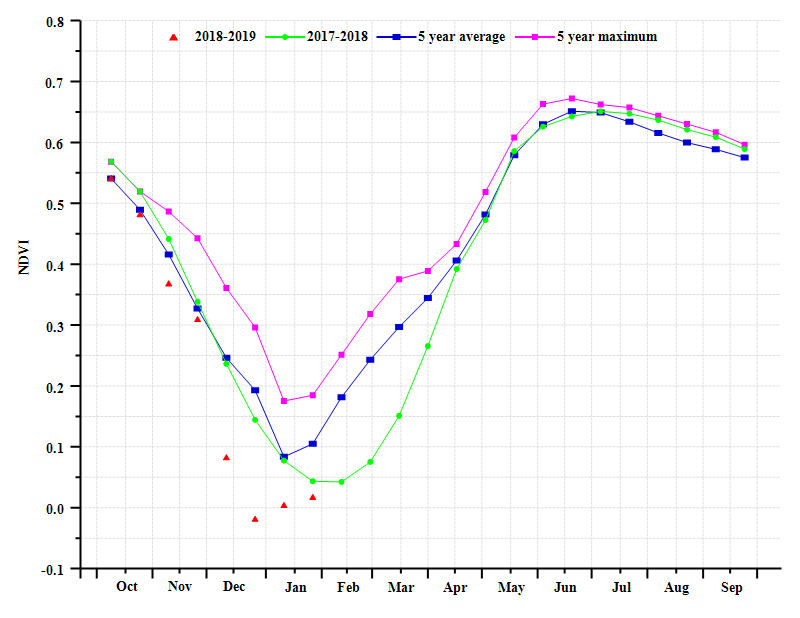
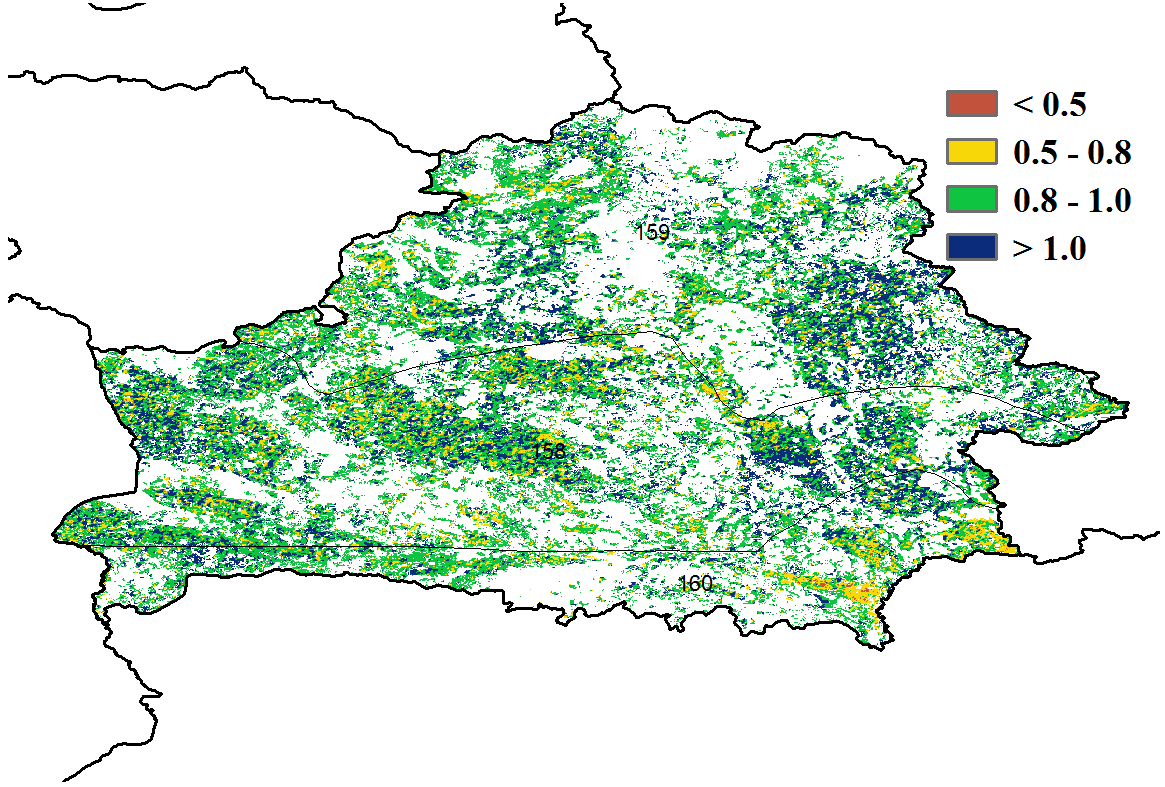
(b) Crop condition development graphbased on NDVI (c) Maximum VCI

(d) Spatial NDVI patterns compared to5YA (e) NDVI profiles
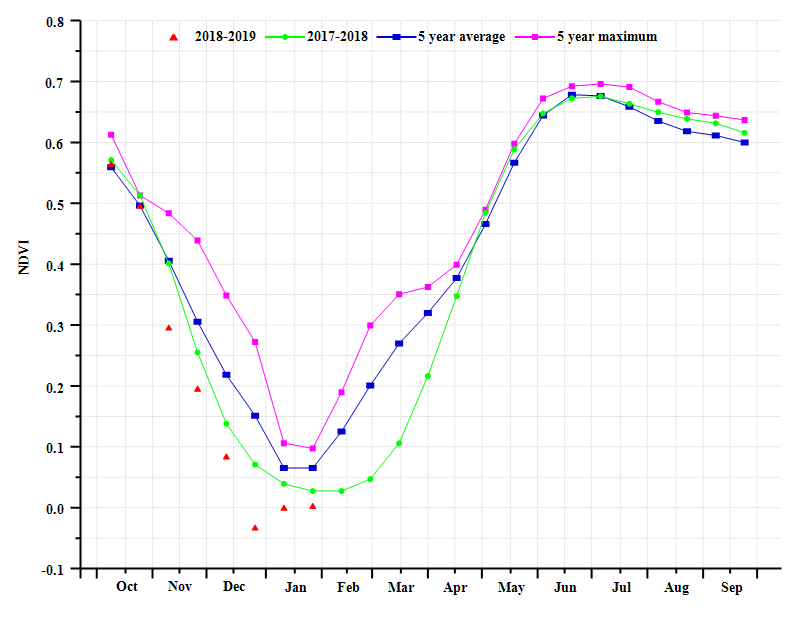
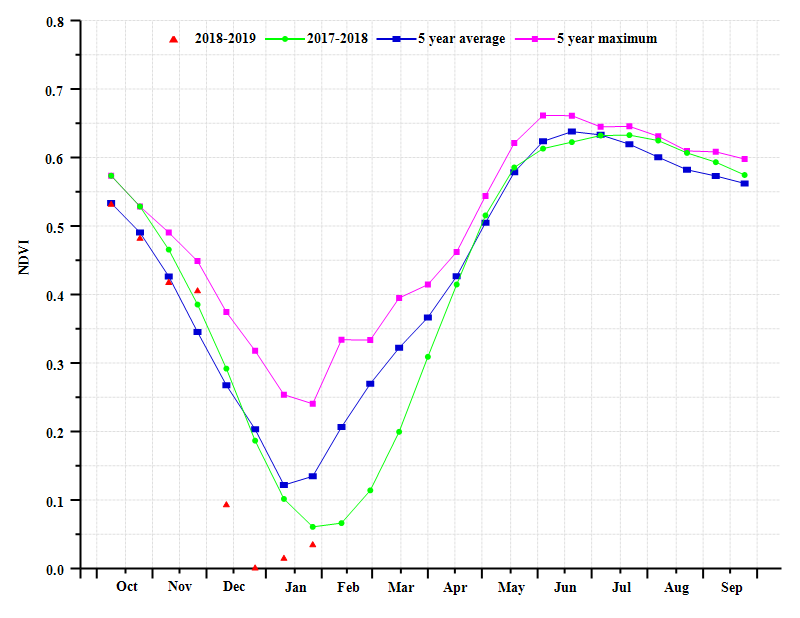
(f) Crop condition development graphbased on NDVI (Northern Belarus (left), Central Belarus (middle) and Southern Belarus (right))
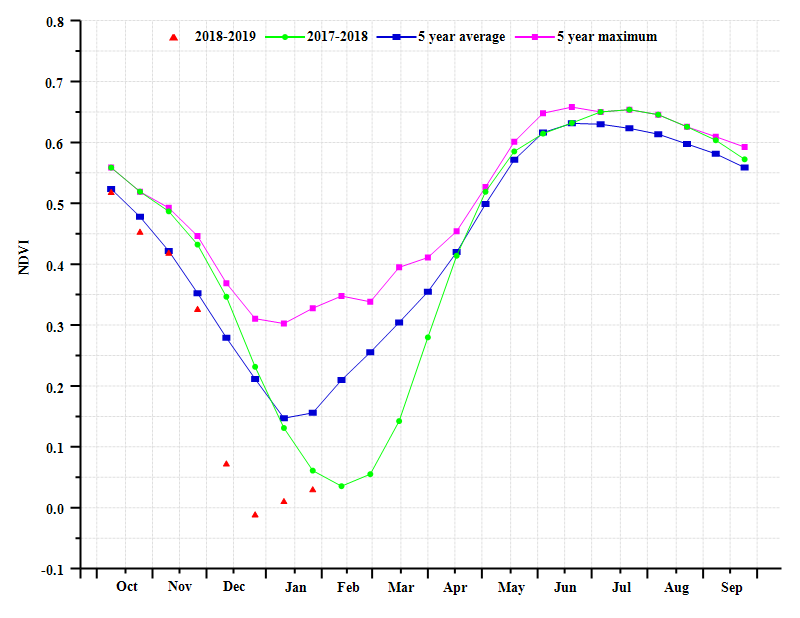
(h) Crop condition development graph based on NDVI_Southern Belarus
Table 3.XX. Belarus agroclimatic indicators by agroecological zones, current season valuess and departure from 15YA, October 2018- January 2019.
| Region | RAIN | TEMP | RADPAR | |||
| Current (mm) | Departure from 15YA (%) | Current (°C) | Departure from 15YA (°C) | Current (MJ/m2) | Departure from 15YA (%) | |
| Central Belarus | 273 | -3 | 1.1 | 0.1 | 186 | 11 |
| Northern Belarus | 256 | -12 | 0.2 | 0.0 | 168 | 16 |
| Southern Belarus | 237 | -12 | 1.4 | 0.1 | 207 | 10 |
Table 3.XX. Belarus agronomic indicators by agroecological zones, current season valuess and departure from 5YA, October 2018- January 2019.
| Region | BIOMASS (gDM/m2) | CALF (Cropped arable land fraction) | Maximum VCI | ||
| Current | Departure from 5YA (%) | Current | Departure from 5YA (%) | Current | |
| Central Belarus | 812 | 7 | 100 | 2 | 0.94 |
| Northern Belarus | 760 | 7 | 100 | 1 | 0.95 |
| Southern Belarus | 827 | 6 | 99 | 2 | 0.91 |
